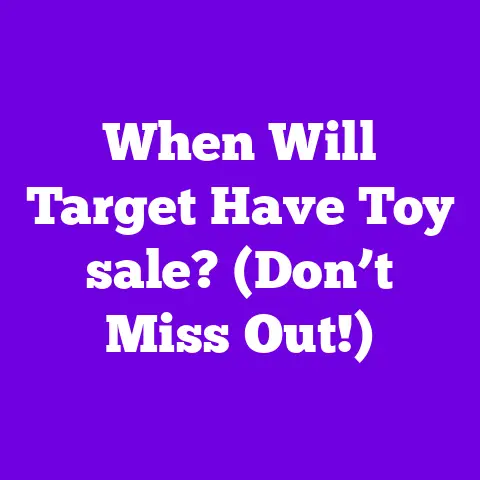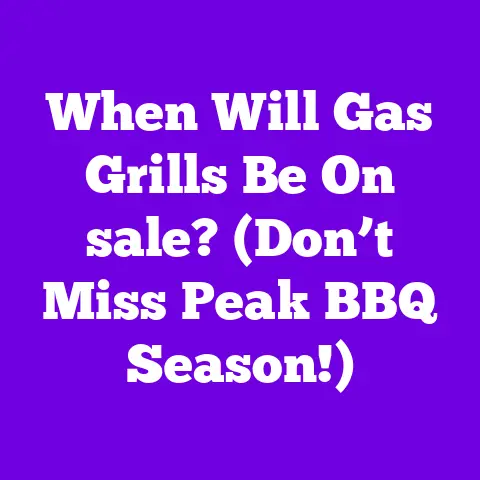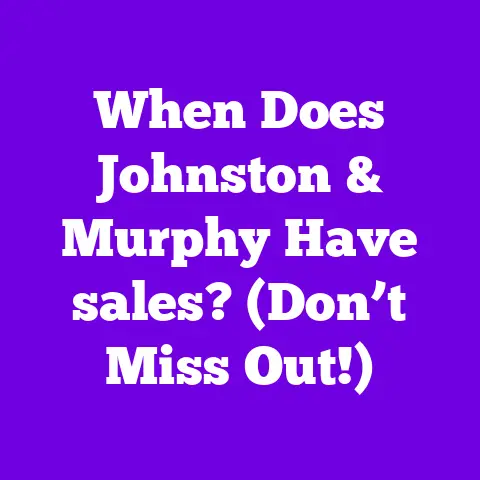When to Close a sale? (Act Now, Deals End Soon!)
In the relentless arena of sales, timing is everything.
But beyond the immediate rush to close a deal, lies a critical element often overlooked: durability.
A sales strategy, no matter how brilliant, is only as good as its ability to withstand the test of time and market fluctuations.
As we move towards 2025, understanding when to close a sale, while simultaneously building a durable foundation for future success, is paramount.
I’ve seen countless sales teams crumble under pressure, relying on fleeting tactics that offer short-term gains but ultimately fail to deliver sustainable results.
In this article, I’ll delve into the art and science of closing sales, emphasizing the importance of acting now, leveraging urgency, and building durable strategies that will thrive in the dynamic landscape of 2025.
Let’s define our key terms:
- Closing a Sale: The culmination of the sales process, where a prospect commits to purchasing a product or service.
It’s not just about the transaction; it’s about establishing a relationship and delivering value. - Urgency: Creating a compelling reason for a prospect to act immediately, typically through time-sensitive offers, limited availability, or highlighting the potential consequences of delaying the decision.
- Durability: The ability of a sales strategy to remain effective over time, adapting to market changes, technological advancements, and evolving customer behaviors.
This article will explore the concept of sales durability, the psychological triggers that influence buying decisions, anticipated market trends for 2025, practical strategies for closing sales effectively, and real-world examples of successful closings.
Understanding Sales Durability
Durability in sales goes beyond simply having a good product or service.
It’s about building a sales process that is resilient, adaptable, and focused on long-term customer relationships.
A durable sales strategy can consistently generate leads, convert prospects into customers, and retain those customers over time, even in the face of economic downturns, technological disruptions, or increased competition.
For example, consider a software company that sells project management tools.
A non-durable sales strategy might focus solely on aggressive pricing and short-term promotions to acquire new customers quickly.
While this might yield initial success, it often leads to high churn rates and a reliance on constant discounts.
A durable strategy, on the other hand, would prioritize building strong relationships with customers, understanding their specific needs, and providing ongoing support and training.
This approach fosters customer loyalty, reduces churn, and generates positive word-of-mouth referrals.
It also allows the company to adapt to changing customer needs and market trends more effectively.
The Key Elements of a Durable Sales Strategy
- Customer-Centric Approach: Focus on understanding and meeting the needs of your customers.
- Value-Driven Proposition: Clearly communicate the value you offer and how it solves your customers’ problems.
- Relationship Building: Invest in building strong, long-term relationships with your customers.
- Adaptability: Be prepared to adapt your sales strategies to changing market conditions.
- Continuous Improvement: Constantly evaluate and improve your sales process.
Case Study: Salesforce
Salesforce is a prime example of a company that has built a durable sales strategy.
They didn’t just sell CRM software; they built a platform that empowers businesses to manage their customer relationships more effectively.
Their focus on customer success, continuous innovation, and a strong partner ecosystem has allowed them to maintain a leading position in the market for over two decades.
According to their 2023 Annual Report, Salesforce’s subscription and support revenues accounted for the vast majority of their total revenue, demonstrating the strength of their recurring revenue model and customer loyalty.
(Source: Salesforce Investor Relations)
Psychological Aspects of Durability: Trust and Long-Term Relationships
At the heart of any durable sales strategy is trust.
Customers are more likely to buy from companies they trust and believe will deliver on their promises.
Building trust requires transparency, honesty, and a commitment to providing excellent customer service.
Long-term relationships are also crucial for durability.
When you focus on building relationships with your customers, you create a sense of loyalty and advocacy.
Loyal customers are more likely to make repeat purchases, refer new customers, and provide valuable feedback that can help you improve your products and services.
The Psychology of Closing a Sale
Understanding the psychological triggers that influence buying decisions is essential for closing sales effectively.
People rarely make decisions based purely on logic; emotions play a significant role.
By understanding these emotional drivers, you can craft messaging that resonates with your prospects and motivates them to take action.
The Power of Urgency
Urgency is a potent psychological tool that can prompt buyers to make quick decisions.
It taps into our innate fear of missing out (FOMO) and our desire to avoid potential losses.
Common urgency tactics include:
- Scarcity: Highlighting the limited availability of a product or service.
- Time-Limited Offers: Creating a deadline for a special price or promotion.
- Fear of Missing Out (FOMO): Emphasizing the benefits that prospects will miss out on if they don’t act now.
However, it’s crucial to use urgency ethically and responsibly.
Creating false urgency or misleading prospects can damage your reputation and erode trust.
Creating Powerful Messaging
Your messaging should convey urgency without being pushy or aggressive.
Focus on the benefits of acting now and the potential consequences of delaying the decision.
Here are some examples of effective urgency-driven messaging:
- “This offer is only available for the next 24 hours.”
- “Limited quantities available – don’t miss out!”
- “Register now to secure your spot at our exclusive event.”
- “Prices are increasing on [date] – act now to lock in the current rate.”
Anecdote:
I once worked with a company that sold online courses.
They were struggling to convert leads into paying customers.
After analyzing their sales process, we realized that they weren’t creating a sense of urgency.
We implemented a time-limited discount for new subscribers, and their conversion rates skyrocketed.
The key was to clearly communicate the value of the course and the benefits of enrolling immediately.
Quotes from Sales Experts:
- “People do not buy for logical reasons.
They buy for emotional reasons.” – Zig Ziglar - “Every sale has five basic obstacles: no need, no money, no hurry, no desire, no trust.” – Zig Ziglar
Market Trends for 2025
As we look ahead to 2025, several key market trends are poised to significantly impact sales strategies and the urgency to close deals.
Economic Factors:
The global economy is expected to continue its recovery from the COVID-19 pandemic, but uncertainty remains.
Factors such as inflation, interest rate hikes, and geopolitical instability could impact consumer spending and business investment.
Technological Advancements:
Artificial intelligence (AI), machine learning (ML), and automation are transforming the sales landscape.
AI-powered tools can help sales teams identify leads, personalize messaging, and predict buyer behavior.
Changing Consumer Behaviors:
Consumers are becoming more demanding and informed.
They expect personalized experiences, seamless online interactions, and instant gratification.
Industry-Specific Trends:
- Technology: Continued growth in cloud computing, cybersecurity, and software-as-a-service (SaaS).
- Healthcare: Increased demand for telehealth services, personalized medicine, and digital health solutions.
- E-commerce: Continued growth in online retail, with a focus on personalized experiences and fast delivery.
Impact on Sales Dynamics:
These trends will shape the sales landscape in several ways:
- Increased Competition: The market will become more competitive, requiring sales teams to differentiate themselves and offer unique value propositions.
- Shorter Sales Cycles: Customers will expect faster responses and quicker results, putting pressure on sales teams to close deals efficiently.
- Greater Emphasis on Personalization: Customers will demand personalized experiences and tailored solutions.
- Data-Driven Decision Making: Sales teams will need to leverage data and analytics to understand buyer behavior and optimize their sales strategies.
Strategies for Closing Sales Effectively
To thrive in the dynamic landscape of 2025, sales teams must adopt effective strategies for closing deals.
Timing is Everything:
Identifying the right moment to initiate closing conversations is crucial.
Pay attention to buyer cues, such as asking detailed questions, expressing interest in specific features, or discussing pricing options.
Data and Analytics:
Use data and analytics to gauge buyer readiness and create a sense of urgency.
Track website activity, email engagement, and social media interactions to identify leads who are actively researching your products or services.
Technology:
Leverage technology to enhance the closing process.
CRM systems can help you manage leads, track interactions, and automate tasks.
AI-powered tools can provide insights into buyer behavior and predict the likelihood of a sale.
Practical Tips for Closing Sales:
- Summarize the Value: Reiterate the value you offer and how it solves the prospect’s problems.
- Address Objections: Proactively address any concerns or objections the prospect may have.
- Offer Options: Provide the prospect with multiple options to choose from, such as different pricing plans or product configurations.
- Ask for the Sale: Don’t be afraid to ask for the sale directly.
Use a clear and confident closing statement, such as “Are you ready to move forward?” - Create Urgency (Ethically): Use time-sensitive offers or limited availability to encourage the prospect to act now.
Real-World Examples of Successful Closings
Let’s examine some case studies of businesses that have successfully closed sales by emphasizing urgency.
Case Study 1: E-commerce Retailer
An e-commerce retailer specializing in home goods ran a limited-time promotion offering 20% off all products.
They sent out an email campaign to their subscriber list, highlighting the limited-time nature of the offer and the potential savings.
The email also included a countdown timer to create a sense of urgency.
As a result, the retailer saw a 30% increase in sales during the promotion period.
Analysis:
The success of this campaign can be attributed to several factors:
- Clear and Concise Messaging: The email clearly communicated the offer and the deadline.
- Countdown Timer: The countdown timer created a sense of urgency and encouraged immediate action.
- Targeted Audience: The email was sent to a subscriber list of people who had already expressed interest in the retailer’s products.
Case Study 2: SaaS Company
A SaaS company offering project management software ran a webinar showcasing the benefits of their platform.
At the end of the webinar, they offered attendees a special discount on their annual subscription plan.
The discount was only available for 48 hours after the webinar.
As a result, the company saw a significant increase in new subscriptions in the days following the webinar.
Analysis:
The success of this campaign can be attributed to:
- Value-Driven Content: The webinar provided valuable information about the benefits of the software.
- Exclusive Offer: The discount was only available to webinar attendees, making it more appealing.
- Limited Timeframe: The 48-hour deadline created a sense of urgency and encouraged immediate action.
Conclusion
In the ever-evolving world of sales, the ability to close deals effectively is paramount.
But success isn’t just about making a sale; it’s about building a durable sales strategy that can withstand market fluctuations and generate long-term results.
By understanding the psychological triggers that influence buying decisions, adapting to market trends, and implementing effective closing strategies, you can optimize your closing rates and achieve sustainable growth.
As we move towards 2025, it’s time to evaluate your own sales strategies and consider how you can implement durable practices to optimize your closing rates.
Act now, before the deals end soon!






